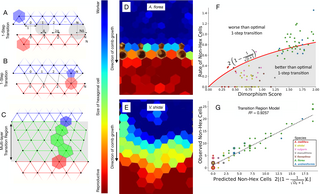Honey bees and social wasps independently evolved hexagonal cells in their nests, but in some species, cell size dimorphism creates an inherent tiling problem. This study shows that despite independent evolutionary origins, building materials, and comb configurations, all species solve this architectural problem using the same solution.
Evolution is cool! It’s especially cool when you can show evolution has arrived at a perfectly mathematically optimal solution too.
It’s also quite interesting that (in many cases) the best way we’ve found to train AI is basically to mirror a natural selection process.Cool paper. I didn’t realize cell size dimorphism was a thing, and it’s super interesting to see the inter-species variation.
This is interesting, I always thought the hexagonal pattern was simply a result of forced circle packing. (i.e., if you squeeze a handful of straws and look at the cross section, they begin to form hexagons)




